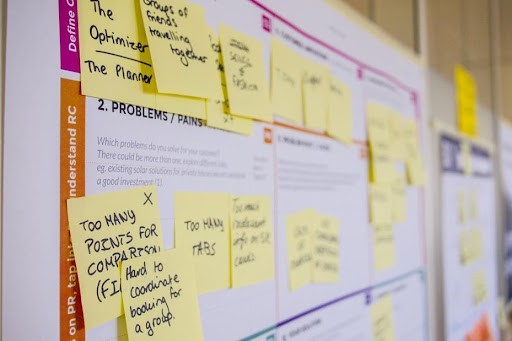What’s all the fuss about Agile methodology ?
Are you familiar with Agile methodology? Whether you’ve had some experience with it or not, this article will give you a deeper knowledge about the tools and philosophy behind them. Agile is a dynamic and flexible approach that's all about collaboration and adaptability, setting it apart from traditional "Waterfall" methods. In this fast-paced world, it's become quite a game-changer!
In this article, we will explore the principles and benefits of Agile, delve into the popular Scrum framework, discuss the concept of Minimum Viable Product (MVP), and introduce the concept of User Stories.

The Agile Manifesto: A new paradigm in project management
The Agile methodology was born out of a desire to address the high failure rates of projects in the 1990s. In 2001, a group of 17 software development experts gathered in the United States and formulated the "Agile Manifesto." This manifesto established four core values that underpin the Agile approach:
Individuals and interactions over processes and tools
Working software over comprehensive documentation
Customer collaboration over contract negotiation
Responding to change over following a plan
Agile Methodology in action
The Agile methodology rejects the notion of exhaustive upfront planning. Instead, it promotes setting short-term objectives and breaking the project into manageable increments. This approach allows teams to embrace uncertainties and changes that inevitably arise during the development process. By fostering a close relationship with the client, Agile ensures that the project stays aligned with evolving customer needs and expectations.
Popular Agile Methods: Scrum and More
Among the various Agile methods, Scrum stands out as one of the most widely used frameworks. Scrum organizes projects into short, iterative cycles called sprints. Each sprint involves planning, development, and regular feedback from stakeholders, culminating in potentially shippable increments of the product.
Apart from Scrum, other Agile methodologies include Kanban, Lean Development, Extreme Programming (XP), Rapid Application Development (RAD), and more. Each method offers a unique approach tailored to specific project needs.
The power of Minimum Viable Product (MVP)
In the world of Agile development, the concept of the Minimum Viable Product (MVP) has proven to be a game-changer. The MVP represents the heart and soul of the product, encompassing the essential features and functionalities required to provide value to early adopters and customers. The idea behind an MVP is to develop a simplified version of the product and deliver it to users as quickly as possible, seeking their feedback and validation. By doing so, development teams can learn valuable insights from real users, validate assumptions, and make informed decisions about the product's direction.
Advantages of the MVP Approach:
Launching an MVP is the secret ingredient for success! By unveiling a Minimum Viable Product early in the development process, teams receive valuable feedback from real users, providing critical insights into user expectations and pain points. The beauty of the MVP approach lies in resource optimization - focusing on core features ensures efficient utilization of resources, preventing wastage. Plus, the MVP's superpower lies in speeding up the time to market! Releasing a functional version of the product sooner gives organizations a competitive edge, swiftly establishing their presence in the market.
But wait, there's more! The MVP journey is all about continuous improvement - as user feedback pours in, teams iterate and enhance the product iteratively. This magical process guarantees the final product meets user needs and exceeds expectations. Not to mention, MVPs work wonders in mitigating risk, as early validation of assumptions reduces the chances of building a product that might not resonate with the target audience. Above all, involving users in the development process creates a sense of ownership and engagement, making them feel valued as they witness their feedback being integrated into subsequent iterations. With MVPs, you'll have all the ingredients you need for a recipe of success!
The User Stories
A story, which is also known as a user story, is a concise request which can be completed in a single sprint. It is written in straightforward language with the user in mind. Story points are a unit of measurement for a story's complexity. A story's primary objective is to add value to its audience within a predetermined time limit.
I want you to think of User Stories as simple, user-centered descriptions of requirements expressed in everyday language. They play a crucial role in Agile development, helping teams understand user needs, prioritize features, and maintain a laser focus on customer value.

Structure of a User Story:
A User Story follows a consistent format, which typically comprises three parts:
The User: This identifies the target user or persona for whom the feature or functionality is intended.
The Action: This describes the specific action or task that the user wants to achieve.
The Benefit: This outlines the value or benefit that the user will derive from the feature.
The Magic of User Stories:
User Stories are the magic potion for effective project communication! They work wonders by promoting clear and concise communication between development teams and stakeholders, eliminating any ambiguity and ensuring everyone is on the same page regarding the project's objectives.
Additionally, User Stories play a vital role in Agile planning, enabling teams to prioritize features based on their significance to end-users. This superpower helps the team deliver the most valuable features first, ensuring a seamless and customer-centric development process.
What's more, User Stories bring the gift of flexibility and adaptability. They are not etched in stone and can be updated and refined as new insights emerge. This remarkable quality allows teams to gracefully adapt to changing requirements and priorities, unleashing their true potential to tackle any challenge that comes their way.
Example of a User Story:
As a registered user (User), I want to receive email notifications when a new article is published (Action) so that I can stay up-to-date with the latest content (Benefit).
Certifications and resources for Agile enthusiasts:

To all Agile enthusiasts looking to boost their project management skills, if you're eager to elevate your Agile journey, we've done the research for you and curated a list of top-notch certifications and training options. Take a look and discover some of the available resources to enhance your Agile expertise:
For certifications that validate your experience, look no further than Scrum.org. Start with the Agile Scrum Master 1 certification, which delves into the essence of Agile as outlined in the revered Agile Manifesto. If you prefer a more immersive learning experience, consider a comprehensive two-day Agile Scrum Master 1 course like the one offered by KnowledgeHut. Looking for alternative training options? Udemy offers an Agile Scrum preparatory course, providing 2.5 hours of video lessons, practical exercises, and bonus resources.
Exciting opportunities await for those who prefer free learning: you'll discover a vast array of valuable Agile content available on major e-learning platforms and numerous YouTube channels dedicated to Agile methodologies. Among them, Google's Certification in Agile, IBM's Introduction to Agile and Scrum and Atlassian's Agile with Jira course, each providing unique insights into the Agile universe. So, if you're keen to expand your knowledge and improve your skill set, take advantage of these fantastic free learning opportunities, and dive into the world of Agile!
Advantages and challenges of Agile Methodology
Agile is a powerhouse for modern projects. Its adaptability and customer focus make it a top choice. With Agile, teams respond to changes lightning-fast, delivering incremental value and blowing away customer expectations. But, brace yourselves – when bringing Agile to traditional organizations, there are challenges.
First, active client involvement and constant collaboration are must-haves. Agile thrives on teamwork and client input, which can be a shift for hierarchical structures. Adapting to this more participative style may take some getting used to.
Next up, it's all about the Agile mindset. Managers and team members need to embrace Agile tools and practices, which might require some rewiring of brains if they're used to more traditional approaches.
And here's the deal: Agile methodologies demand change. Traditional organizations might resist or lack the right culture for it. But fear not, by encouraging open communication, embracing experimentation, and providing regular opportunities for learning and growth, we'll overcome inertia and nurture a culture of continuous improvement.

As you explore the benefits of Agile methodologies, investing in these innovative approaches is undoubtedly worthwhile. Not only do they bring time and performance gains, but they also align seamlessly with our mission at JobBee. Many of our valued clients leverage Agile methodologies to excel in their projects.
So, whether you're an experienced developer or new to Agile, we hope this article has provided valuable insights. At JobBee, we're committed to your success and growth in the tech industry. Embrace the power of Agile, explore the exciting opportunities with JobBee, and let us be your guide on your path to success!











